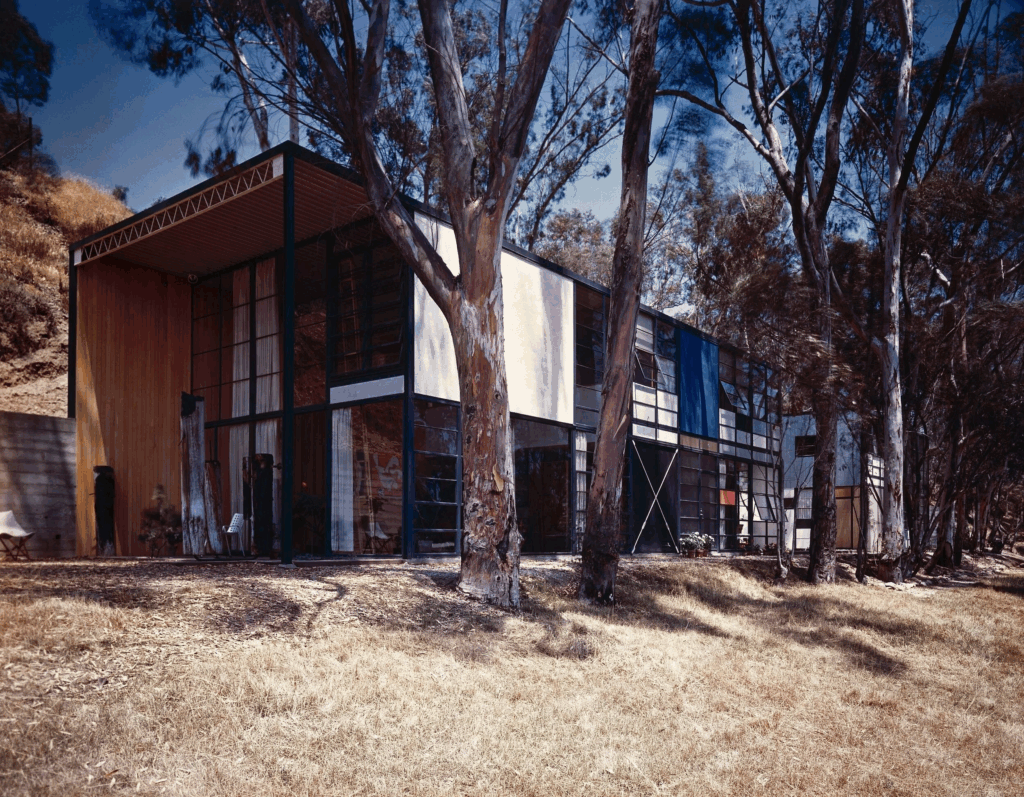Few names in the world of design carry as much weight as Charles and Ray Eames.
Together, they redefined what furniture could be — functional, elegant, affordable, and deeply human. Their creations, from the iconic Eames Lounge Chair to the playful Eames House, are not just objects or buildings; they are symbols of optimism, creativity, and the modern age.
A Creative Partnership Like No Other

Charles Eames was born in 1907 in St. Louis, Missouri, and trained as an architect. Ray Kaiser Eames, born in 1912 in Sacramento, California, studied painting and was a student of the renowned abstract artist Hans Hofmann.
The two met in 1940 at the Cranbrook Academy of Art, where they collaborated on experimental furniture designs using molded plywood. Their shared curiosity and joy in making things quickly became the foundation of one of the most influential design partnerships in history.
They married in 1941 and moved to Los Angeles, where they established the Eames Office — a creative laboratory that blurred the boundaries between design, art, architecture, and film.
The Birth of Modern Comfort
During the 1940s, Charles and Ray began experimenting with molded plywood, a revolutionary material at the time. They developed techniques for bending wood into organic, ergonomic shapes that could cradle the human body.
Their first major success came with the Eames Molded Plywood Chair, hailed by Time magazine as “the chair of the century.” Lightweight, affordable, and beautiful, it embodied their belief that good design should serve everyone.
In 1956, they introduced the Eames Lounge Chair and Ottoman, produced by Herman Miller. Combining luxurious materials — walnut veneer, supple leather, and precise engineering — it became an instant icon of mid-century modern design.
Even today, the Eames Lounge Chair remains one of the most desired furniture pieces in the world, symbolizing comfort, craftsmanship, and timeless elegance.

The Eames House: Living as an Experiment

In 1949, the couple designed and built their own home, known as the Eames House or Case Study House No. 8, in Pacific Palisades, California.
Made of industrial steel and glass panels, the house was conceived as a modular, affordable design — yet it radiated warmth and personality. Inside, it was filled with books, textiles, art, and handmade objects collected during their travels.
For Charles and Ray, the Eames House was not just a place to live; it was an ongoing experiment in how architecture and daily life could coexist beautifully. It remains one of the most beloved examples of mid-century modern architecture in the world.

Design Philosophy: “The Best for the Most for the Least”

At the core of the Eames’ work was a simple, powerful idea: design should serve people.
They believed that well-designed objects could improve everyday life and that beauty was inseparable from function. Their motto, “The best for the most for the least,” reflected their democratic approach — they wanted to make high-quality design accessible to everyone, not just the elite.
Their projects ranged from chairs, toys, and textiles to exhibitions and films. Whether designing a piece of furniture or an information display for IBM, they approached every problem with the same curiosity and rigor.
“Recognizing the need is the primary condition for design.” — Charles Eames
The Eames Office: Where Design Met Play
The Eames Office was more than a studio — it was a playground for ideas.
Filled with artists, engineers, and thinkers, it became a hub of creativity where architecture, film, photography, and industrial design overlapped.
Charles and Ray believed that design was a process of discovery, not decoration. They documented their ideas in short films such as Powers of Ten (1977), which explored the scale of the universe — from the microscopic to the cosmic — and expressed their belief that good design connects all levels of existence.
Their work ethic was joyful and collaborative. They often said, “Take your pleasure seriously.”
Lasting Impact on Design and Culture
The influence of Charles and Ray Eames extends far beyond their furniture.
They helped define American modernism, inspired generations of architects and designers, and reshaped how people thought about living, working, and learning.
Their designs remain in continuous production today through Herman Miller and Vitra, testament to their timeless appeal. Museums like the MoMA in New York and the V&A in London continue to celebrate their work as foundational to modern design history.
Their blend of warmth, simplicity, and innovation laid the groundwork for the minimalist aesthetics of brands like Apple and Muji decades later.
Why the Eames Legacy Still Matters
In a world obsessed with trends, the work of Charles and Ray Eames endures because it was never about fashion — it was about humanity.
Their designs feel as fresh today as they did 70 years ago because they speak to universal needs: comfort, function, and joy. They understood that great design doesn’t just look good; it makes life better.
From their plywood experiments to their timeless lounge chair, the Eames remind us that good design is not about luxury — it’s about empathy, curiosity, and optimism.
“Design is not just what it looks like. Design is how it works.” — a philosophy Steve Jobs later echoed, inspired by the Eames’ legacy.



